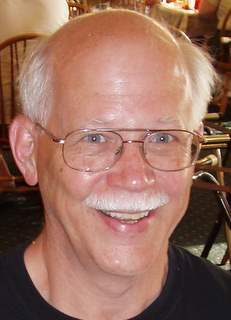North Coast Wood Turners sponsored a demonstration and class with Alan Carter this last Saturday and Sunday. Saturday was a demonstration of Alan's methods of creating both suspended vessels and thin-stemmed vessels. Sunday was a hands-on class in which turners got to try making one or the other of the vessels demonstrated the previous day. Saturday around a hundred members attended the demonstration and Sunday nine members took the class.
Alan is from the Chicago area and involved in that local wood turning club,
Chicago Woodturners. He initially was a painter, then furniture maker, and now wood turner. His website
[link] has some examples of the beautiful work that he is doing. One of his more elaborate suspended vessels was the cover art for the June, 2011 issue of Woodturning Design.
Alan's demonstration of turning a suspended vessel was much less elaborate than this example, but did include techniques for hollowing using Easy Wood tools and methods for aligning the wood or brass pins that suspend the vessel from the supporting structure. Although I took extensive notes and intend to try this style of turning, I chose the thin stemmed vessel for the Sunday class.
Alan offered one-on-one attention to each student and gave me several pointers that would apply to almost all my turning.
The Process

Alan wrote an article on turning the thin-stemmed vessel and a copy of that article
[link] is available in PDF format from his website. The stem is turned from a 1 1/2 to 2 inch square maple blank which can range from 6 to 12 inches. We were working with the shorter lengths. After the end is created to receive the top vessel, the stem is gradually reduced in thickness working one inch at a time. It is a lesson in patience to work slowly and carefully. As the thin section gets longer and longer, the degree of caution and delicacy has to increase to prevent flexing of the stem. By the time I got to the beginning of the thicker base, I was feeling quite tense.
The top vessel can take on many shapes and additional elements including collars and finials. Mine was a simple cup shape made from walnut about the same diameter as the stem base. Once the top vessel is completed, they are epoxied together and spray finished.
This picture is my turning from that class. It is a maple stem with walnut vessel. It is about 8 inches high and 1 3/4 inches at its widest. The stem is 1/8 inch thick.
This turning was challenging for me since it is my first experience turning such a delicate thin stem. I have pulled out some additional wood blanks to practice these skills and may try for ones a little taller with different types of top vessels.











